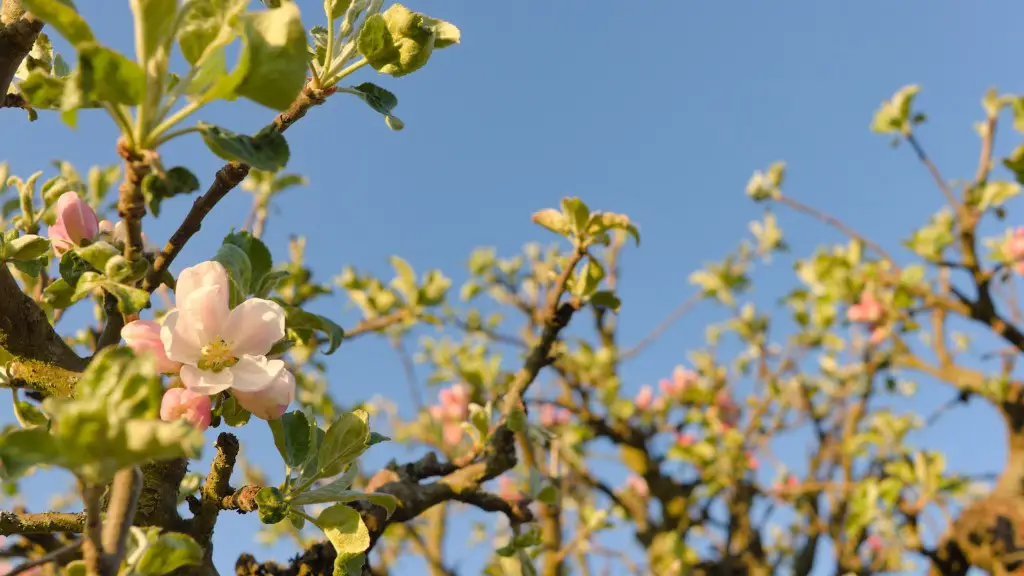When it comes to apple trees, deciding when to cut back the branches requires careful consideration. Generally, winter pruning should take place when the tree is dormant, when there are few insect and disease issues and when the tree is not actively growing. Apple trees should be pruned every year and the amount of pruning a tree needs will depend on its age, size, and the time of year in which it is being pruned. Always evaluate the tree for any signs of stress before beginning pruning.
Apple trees should be pruned annually to remove the old and diseased wood, to open up the canopy for better light and air movement, and to help promote healthy new growth. Pruning is essential for young apple trees since it helps to promote strong structure and promotes healthy, productive growth. Pruning should be conducted when the wood is still relatively young and supple.
During winter pruning, it is important to consider the health of the tree. Before pruning, inspect the tree for any signs of disease or damage and remove any dead or diseased branches right away. Be sure to use sharp, clean pruners so as not to damage the tree or spread any potential diseases. When pruning apple trees, it is important to keep the desired shape of the tree in mind as you can quickly ruin the shape of the tree by removing too much of the canopy all at once.
When pruning apple trees, it is also important not to cut off too much of the interior, that is the branches that are located deep in the center of the tree. Removing too much of the inner branches can result in a weak and unbalanced tree structure. It can also create a tree that is too sparse, leaving the center bare. When pruning, aim to remove taller, more vigorous shoots and thin out overly dense areas in order to open up the canopy as much as possible.
When pruning apple trees, aim to remove no more than one-third of the tree’s mass. Thinning the canopy helps to allow for more light and fresh air to enter the tree’s center and to promote new growth on lower and interior branches. When pruning, you should also aim to maintain a “vase-shaped” structure – making sure to keep the bottom of the canopy slightly smaller than the upper half of the tree. This helps to promote new growth and allows for better sun exposure on the top half of the tree.
Summer Pruning
Sometimes summer pruning may be necessary when training younger trees or when structural damage is required. Summer pruning will be done in order to shape the tree into its desired form. Summer pruning should not involve more than light reshaping and should be done when the tree is young and the branches are slender and easy to shape. Unlike winter pruning, summer pruning should involve the removal of only short shoots and should be limited in order to avoid further damage to the tree.
If summer pruning is done on established trees, make sure to remove no more than one-third of the tree’s canopy in order to maintain its proper shape and structure. Removal of more than one-third of the canopy can result in the tree becoming too sparse and unbalanced. Summer pruning should only be done when absolutely necessary and should always be done carefully, as it can potentially damage or even kill the tree if done too aggressively.
Light Pruning
Light pruning can be done in either the summer or winter months in order to thin out overly dense areas of the canopy and promote better light and air movement within the tree. Aim to remove no more than one-third of the tree in the open up the canopy and remove any excessively long shoots that may be blocking light from its lower branches.
When thinning excessively dense sections of the tree, be sure to leave multiple branches coming off the trunk or main branches. This helps to ensure that the tree’s structure remains balanced. Thin out overly dense sections in order to allow for better light penetration and air movement throughout the tree’s canopy.
Light pruning should not involve the removal of any additional lateral branches or main branches. This type of pruning should only be done to thin out areas of the canopy and to help promote healthy new growth.
Heavy Pruning
Heavy pruning is more drastic than light pruning and involves the removal of entire branches and limbs. Heavy pruning should only be done as a last resort, as it can result in the tree becoming unbalanced and open to disease and pest infestations.
Heavy pruning should only be done in cases of severe damage or infection, when the entire branch or limb is dead and no longer able to produce new growth. Before pruning dead or substantially damaged branches, inspect the tree for signs of disease or pests and remove any that are present.
Heavy pruning should be done in the winter months, when the tree is dormant and is not actively growing. Branches should be cut at the point of origin and any remaining stubs should be treated with a pruning sealer in order to ensure that it does not become infected.
In cases of severe disease or infestations, it may be necessary to prune off an entire limb or part of the main trunk. If this is the case, the pruning should be done carefully and only as a last resort.
Pruning Tools and Safety
It is important to use clean and sharp tools when pruning in order to avoid damaging the tree or spreading any potential diseases. Always use clean, sharp, and well-maintained pruning tools. Pruning tools should be cleaned and sterilized between uses in order to prevent the spread of infection or disease.
When pruning, always use proper safety precautions, such as wearing gloves and eye protection and using a ladder when necessary. Pruning branches that are high up in the tree can be dangerous, so it is important to use caution.
Always inspect the tree for signs of disease and pests before pruning and remove any affected branches immediately. Special care should be taken when pruning a young, newly planted tree and pruning should be limited to just a few branches in order to promote healthy, strong growth.
Pruning apple trees is essential for their health and productivity, but it is important to know when and how to prune in order to avoid damaging the tree or spreading infection or disease.


